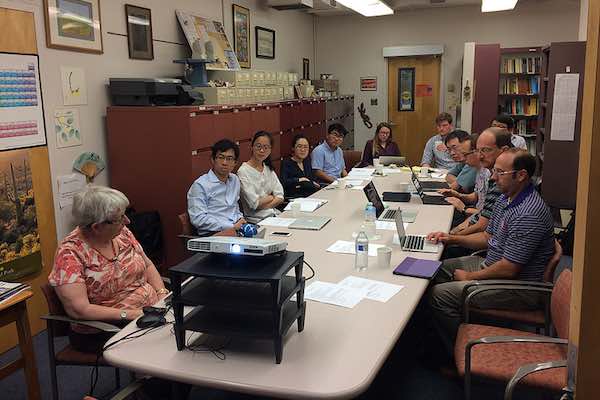
[Image above] Members of the ALEXSYS workshop in June 2017, which marked the formation of the Thermodynamics Consortium.
With a whole host of new materials constantly being developed—from hybrids to metal-organic frameworks to novel nanomaterials—thermodynamic data has not been able to keep pace with the frequent introduction of new materials.
Thermodynamics—the physical concepts focusing on a system’s macroscale responses to work, heat, and energy—really form the basis for understanding reactivity, transformation, and stability.
That makes these concepts integral to synthesis, corrosion, environmental transport, catalysis, biological reactivity, and much more. In other words, they are incredibly important for nearly any process you can think of.
And it’s because of this integral importance that a lag in quality thermodynamic data is a significant concern.
But have no fear—the Thermodynamics Consortium is here.
This recently established consortium (ThermoCon) is aiming to bolster thermodynamic research by enhancing interactions, collaborations, and activities of a wide variety of scientists involved in thermodynamics research.
According to Alexandra Navrotsky, one of the consortium’s founders, “ThermoCon is a diverse and energetic international community of researchers from academia, national labs, and industry who together will advance modern thermodynamic research to solve a variety of scientific and technological problems, change the way the academia, national labs, and industry interact, and bring fundamental and applied thermodynamics closer together—thus making broad global collaborations among many sectors the new future.”
The consortium was dreamed up during a June 2017 workshop of experimental thermodynamicists and materials scientists at the Peter A. Rock Thermochemistry Laboratory at the University of California Davis. And it hasn’t taken long for the idea to cement and gain a diverse membership.
That membership currently includes around 200 experts in chemistry, physics, materials science, chemical engineering, geology, and mineralogy.
This diverse group of scientists—hailing from 13 countries across 4 continents—have similarly diverse specialties, including computational thermodynamicists, crystallographers, spectroscopists, and scientists studying complex structures and reactivity.
And it’s this cross-disciplinary, international makeup that allows ThermoCon to foster new ideas, research collaborations, and fruitful dialogue, in addition to sustaining activities such as training young scientists and supporting funding initiatives.
One of the areas that the consortium is focused on is continuing to close gaps between experimental and theoretical work, “making narrowly defined ‘pure science’ a thing of the past and interdisciplinary studies, novel and hybrid materials, and broad collaborations across academia and industrial R&D the new future,” according to the website.
A primary benefit of many consortiums is simply the ability to nucleate individuals interested in particular topic into a collective to share information, building relationships and offering networking opportunities along the way.
An additional critical aspect of ThermoCon, however, is aimed at process improvements that address some of the challenges of acquiring thermodynamic data in the first place. The consortium plans to bring together its interdisciplinary experts to develop experimental solutions, share and lend equipment, and even facilitate procuring supplies.
“Additionally, the core founders have built or are currently developing multipurpose calorimetry facilities, which will be beneficial for building long-lasting collaborations, establishing the next generation of thermodynamicists, and expanding the consortium further,” according to Kristina Lilova, ThermoCon coordinator.
Yet another key aspect of the consortium’s proposed process improvements is working directly with suppliers in industry to better meet the needs of researchers.
“The current market is based on perceived demand based mostly on a company’s own statistics and less on the messages coming from the users,” Lilova says. “One of our founders (Navrotsky) has a long history working a manufacturer of calorimetric and thermal analysis equipment. Her custom-built Tian-Calvet calorimeter was commercialized as the Setaram AlexSYS, largely because one scientist from Europe requested it, and she was willing to work with the company to improve the original design and develop the commercial version. Eight years later, there are currently 12 instruments worldwide and at least two more are expected within the next 1–2 years.”
That first-hand knowledge and experience is precisely what industry experts need to develop better equipment and products, but it’s one perspective that they’re often lacking because of a lack of dialogue. Lilova says that other consortium members have also similarly custom-built their own equipment to meet unique research needs, representing a potentially valuable asset for companies and researchers alike.
In addition, bringing consortium members together is critical to help build the organization’s collective, so in addition to annual workshops for consortium founders, Thermocon is also planning to organize special events for all its members and beyond, such as a focused session at MS&T18 and symposia at MS&T19.
Through the consortium’s diverse makeup, it certainly holds the power to enhance broad collaborations that will enable it to meet some of its powerful goals.
Interested in finding out more information and potentially joining ThermoCon? Visit the website for more details.
Did you find this article interesting? Subscribe to the Ceramic Tech Today newsletter to continue to read more articles about the latest news in the ceramic and glass industry! Visit this link to get started.
